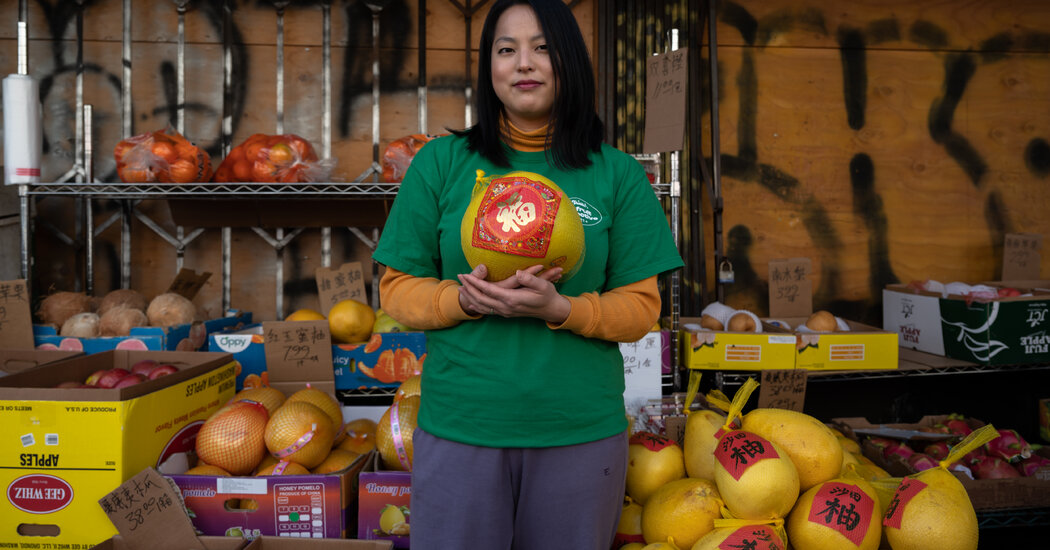Oranges. Apples. Pomelos. Eating or giving fruit is a beloved Lunar New Year tradition in many Asian cultures, expressing love and thought to bring good luck.
In the days leading up to the Lunar New Year, Daphne Wu would wait for a pomelo to ripen.
Her family would buy at least one every year and set it on the counter. It got sweeter and sweeter as the New Year approached.
Pomelos, which are similar to grapefruits, are said to bring prosperity to whoever eats them, but they are notoriously difficult — and time-consuming — to crack open.
The practice of peeling the fruit together brought Ms. Wu’s family closer, and the taste of the pomelo was just a bonus. “It’s amazingly sweet,” said Ms. Wu, 33, a web designer and a co-founder of the Cut Fruit Collective, an organization in the San Francisco Bay Area that supports Asian Americans and Pacific Islanders.
Eating, and giving, fruit are among the customs that many Asian families, like Ms. Wu’s, practice for the Lunar New Year. This year, the holiday will fall on Tuesday, as the moon enters a new phase and ushers in the Year of the Tiger. Celebrations often last two weeks.
Lunar New Year traditions vary among Asian cultures, but their goal remains the same: to bring luck and prosperity. There are other traditions, too, such as exchanging red envelopes containing money and eating long noodles for a long life.
Many of the traditions stretch back thousands of years, to when the Lunar New Year was first celebrated. They are so ingrained in the cultures that it is hard to trace their origins.
Still, it is widely agreed upon that some types of fruit, because of their names or colors, are considered lucky. Apples are said to bring peace to whoever eats one, because the Chinese word for “apple” sounds like the word meaning “peaceful.” The same goes for pomelos and the protection they offer. Golden-hued fruits like oranges, tangerines and kumquats are believed to bring wealth to those who eat them, their gold colors reminiscent of money.
That’s why Ms. Wu’s family makes sure to eat plenty of kumquats and oranges over the New Year. They also give bags of tangerines as gifts.
At Viet Duong’s house in Houston, after everyone’s bellies were full of curry and caramelized salted tofu during the New Year celebration, they would dig into something else: fruit.
In addition to oranges and apples, they often had dragon fruit and star fruit, which are supposed to bring good luck. Mr. Duong’s parents always cut up the fruit and placed it in the refrigerator so it was ready to be served right after the main course, said Mr. Duong, 36, a health care worker.
“There was never cake or ice cream,” he said, but “there are always cut fruits.”
Linda Trinh Vo, a professor of Asian American studies at the University of California, Irvine, said that fruit was “a language of love” during Lunar New Year and that it could be given in many ways. Some families grow their own tangerines or kumquats to give away, while others give roots or seeds from fruit plants in their yards. Fruit can also be purchased in neatly packed gift boxes at grocery stores.
“It’s hard in many Asian American cultures to say the words ‘I love you,’” she said, “so they do it through serving these special delicacies.”
Whether it comes wrapped in a box or sliced on a plate, fruit is seen in many Asian cultures as a silent gesture of love, said Randy Su, 22, of Toronto, who is studying for his master’s degree in teaching.
At Mr. Su’s home on Lunar New Year, his parents serve plates of cut fruits “like a party tray” to their guests, he said.
The fruit is “a show of hospitality,” he said, but it’s also a way to show the guests that “they’re thinking about you and care for you and love you.”


























